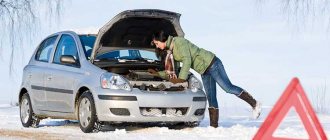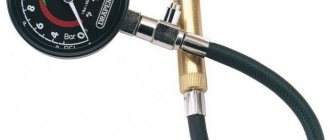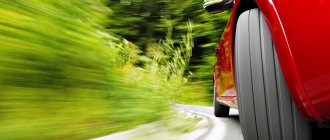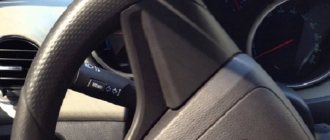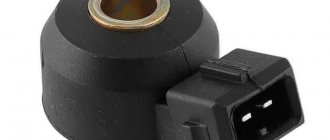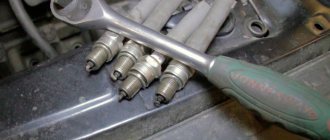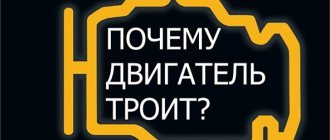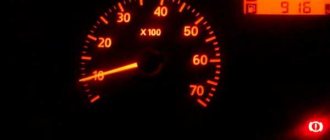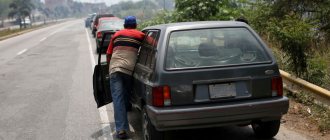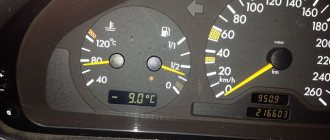Identifying possible causes of knocking
Turning the steering wheel of front-wheel drive cars involves many joints, levers and rubber seals. A knocking sound in the steering wheel when turning may indicate wear of components or parts.
First of all, the assistant can turn the steering wheel, and you can listen to sounds under the car. Sometimes it is difficult to determine a breakdown by hearing, so you can touch various parts with your hand.
Wheel arch protection
One of the common causes of knocking is loosening of the wheel arch protection. In this case, it first turns under the action of the wheel, then returns to its original position, which gives rise to a characteristic “plastic” sound. Reliable fixation of the plastic protection takes a few minutes.
Hinges
Knocking when turning wheels can be generated by hinge joints: steering tips and rods, earrings and stabilizer rods. The noise occurs when a dirty or unlubricated joint jams. Sometimes it is enough to lubricate it, sometimes it is necessary to replace it.
CV joint
A metallic crack that accompanies a full turn of the steering wheel may indicate a breakdown of the constant velocity joint, or in popular parlance, a “grenade”. A cracking sound when turning in both directions means that both “grenades” need to be replaced. Failure of CV joints is usually associated with a rupture of the rubber boot that protects the mechanism body. Even a small tear is enough to create the need to replace one of the most expensive components of the chassis. Therefore, it is better to check the anthers once a month for damage.
Silent blocks and ball joint
Noise can be caused by heavily worn-out rubber silent blocks and ball joints. In this case, when the wheels turn, the lever becomes skewed, which generates the sound.
Front pillar
If the steering wheel of a stationary car knocks when turning, then very often this means a breakdown of some part of the front strut. Some of these faults can be found directly, others can be found by dismantling and disassembling the rack.
Strut bearing
The stand is attached to the car body with two or three nuts. Its support is made of elastic materials that soften body vibrations. The stand rotates using a support bearing. A strong knock occurs when it jams due to deformation of the holder or lack of lubrication.
Strut spring
This spring is fixed by special rubber or plastic bumpers with cavities. When turning the wheels, the spring must remain motionless. If it is broken or comes out of its seats, a knocking noise occurs.
A knocking noise when turning occurs when the wheel bearing wears out. It is easy to diagnose such wear. You need to shorten the wheel on the sound side and check the axial play by rocking the wheel. If there is play, the bearing must be replaced, which requires appropriate equipment and knowledge. Often both bearings fail at the same time. This can be serious. The complexity of the repair here lies in the procedure of “pressing” the bearing out of its place in the hub. Such a diagnosis is fraught with long-term, expensive “treatment”, and failure to take action in a timely manner can lead to complete destruction of the front suspension.
Non-standard reasons
Often the sound is not caused by a faulty part, but by something completely different. For example, one car owner got it after a pebble flew onto the subframe of his car and got stuck there. The elements of the steering column ran over a pebble and jumped off it, generating a sound. After removing the pebble, it disappeared.
Another car owner's front arm, which was replaced after a suspension repair, began to hit the subframe when turning, which caused a knocking sound. In this case, it was enough to lift the subframe with a pry bar.
Subframe (atypical situations)
Sometimes atypical situations that are quite difficult to diagnose lead to knocking when turning. For example, there is a known case when, while the car was moving, a small stone hit the subframe and got stuck there. When you turn the steering wheel in one direction or the other, a natural displacement of the steering gear elements occurs, and they seem to run over this stone. When the elements were restored to their original position, they jumped off the stone, making a characteristic sound. The problem was solved by removing the stone.
When repairing suspension elements, for example, when replacing the front arm, the latter may touch the subframe when turning the wheel. Naturally, this is accompanied by a blow and a grinding sound. To get rid of it, it was enough to lift the subframe using a pry bar.
Another atypical situation of knocking in the suspension when turning is that the subframe bolt loosens, and the subframe itself can knock when driving, and even more so when turning. It can be eliminated by tightening the corresponding bolt.
Conclusion
It is unsafe to drive a car that makes a knocking noise when you turn the steering wheel. Any breakdown that leads to this will only get worse over time, which will ultimately lead to complex, expensive repairs, as well as dangerous driving. Therefore, if a knocking noise is detected when turning a wheel, it is necessary to carry out diagnostics as quickly as possible and take appropriate measures to eliminate the cause that caused it.
Extraneous sounds during vehicle operation are very disturbing. It is better to identify the causes of malfunctions as quickly as possible and eliminate them at the initial stage, otherwise car repairs may become more expensive. Let's figure out why noises/clicks may appear when turning the steering wheel.
The steering design of modern Lada cars (Priora, Kalina, Granta, Largus, Vesta, Niva and XRAY) is practically the same. Therefore, the possible causes of malfunctions are similar:
- The tie rod ball joint nuts are loose (No. 2 in photo No. 1).
- The gap between the steering rack stop and the nut has been increased (photo No. 2). Tighten the steering rack.
- The steering rack fastening has become loose (No. 1, 19, 21 photo No. 3).
- The outer constant velocity joints (CV joints) are worn out (No. 1 photo No. 4).
- Increased axial play of the wheel (severe wear of the front wheel bearings No. 3 photo No. 5 or loosening of the hub nut No. 6)
- The fastening parts of the front suspension have become loose, photo No. 6 (fastening the stabilizer bar to the body, the front suspension steering knuckle to the strut, the nuts of silent blocks of the suspension arms, braces, strut support).
- The shock absorber strut support bearing (No. 4 photo No. 7) or the rubber support element is worn out.
- The suspension spring broke (No. 6 Photo No. 7).
- The wheel mounting bolts have become loose, photo No. 8.
According to the AvtoVAZ technical bulletin dated December 15, 2015, the cause of a squeak when the steering wheel rotates may be an insulating gasket that needs to be cut.
Have you encountered a knocking or squeaking sound when turning the steering wheel? What was the cause of your problem? Also, the cause of extraneous noise when turning the steering wheel may be play in the crosspiece of the steering shaft or a gearless electric power steering.
Causes of knocking when turning
Steering rack. Malfunctions of the steering rack quite often lead to various unpleasant phenomena, among which knocking is not the least important. The cause of the knocking in this case may be wear in joints or working mechanisms, for example: a worm gear, a rack, or a worm. This problem can be solved by restoring the steering rack or by completely replacing it.
Steering tips. When play appears in the tie rod ends, it is quite possible that you will hear a knocking sound when turning the steering wheel. Such breakdowns occur as a result of natural wear and tear, as well as high loads, for example, due to driving on uneven roads at high speed. This malfunction can be eliminated by replacing the tie rod ends; the work is not difficult and absolutely doable at home.
Support bearings. Quite often there are cases when it is not the shock absorbers that fail, but the slewing bearings that are installed in the upper part of these struts. Frequent impacts or off-road driving often cause the bearings to fail, resulting in a knocking sound when turning the steering wheel. The issue of faulty support bearings is resolved by complete replacement or by disassembling and replacing faulty parts, followed by lubrication of the working parts.
Steering cardan shaft. Malfunctions of this unit can lead to dull knocks in the area of the steering column. Failure of the driveshaft is caused by the same conditions as in previous cases - increased loads and serious wear due to constant vibrations and shocks. In addition, failure can occur as a result of damage to the anthers or lack of lubrication. There are several solutions to this issue, for example, you can try to replace the driveshaft or crosspiece; if this is not possible, you will have to replace the assembly.
Wheel bearings. This problem can only appear while driving, so if there is no knocking when turning the steering wheel in place, but appears while driving, then most likely the reason will be in the chassis. One common cause is the wheel bearing, which, if faulty, can make a knocking sound. Checking the wheel bearing is quite simple, just hang the wheel and try to swing it in different directions, if you hear a knock, the bearing is faulty. In addition, the bearing can be checked while driving; a faulty one will emit a hum (howl), which will intensify depending on the speed of your car.
CV joint A constant velocity joint (CV joint), or more simply put, a grenade, can also simulate a knock when turning the steering wheel, but this knock is more like a crunch and is heard, as a rule, when the steering wheel is fully turned. Moreover, this crunch will occur exclusively when turning in one direction and only while moving. Therefore, if you turn the steering wheel while standing still and you don’t hear any knocking noise, most likely the reason is not in the steering mechanism.
In order to accurately establish the cause, it often takes a lot of time; moreover, situations often occur when it is simply impossible to independently understand where the knocking comes from when turning the steering wheel. In such cases, I recommend not to delay diagnosis and repair; immediately seek help from specialists; as a rule, they quickly find the cause and eliminate it without any problems in the shortest possible time. This option would be better than simply doing nothing and driving until something falls off somewhere or gets jammed while driving...
That's all
Thank you for your attention and for reading to the end. Leave your comments using a special form, in which you can talk about your own experience in dealing with knocking or simply share your impression of the article you read
I wish you all the best and see you again at autoposobie.ru. Bye!
Quick Guide
The main reason for tapping is the formation of a gap in the joints. In the steering system, there may be knocking on the tips, ball joints of the rods, the rack, the “cardan” in the column, the steering wheel on the shaft, or the auto-folding system in case of an accident. The metallic sound is distinct and can be heard in place when rocking the steering wheel.
It is quite possible to mistake problems in the suspension for problems in the steering, since the initial stages of wear of bearings and supports only make themselves felt when cornering at speed. In the suspension part, the cause of the knock should be sought in the wheel bearings, ball joints and “supports”.
1200 rub. for the photo report
We pay for photo reports on car repairs. Earnings from 10,000 rubles/month.
Write:
A knocking sound when turning the steering wheel indicates problems with the vehicle's steering system. The causes of knocking may be malfunctions of the constant velocity joint (CV joint), ball joint, wear of the steering tip and/or support bearing, stabilizer link and other malfunctions. In any case, when a knock is heard when turning the steering wheel, it is necessary to carry out diagnostics as quickly as possible, since malfunctions of the steering system not only worsen over time, but can also lead to emergency situations when the car is moving, even an accident.
It's the suspension that makes the sound.
Usually we can talk about this for sure only after diagnosis. At the stage when all that remains is to replace the faulty parts. Otherwise, by trial and error, you can move ad infinitum, and then still find a forgotten glass bottle rolling along the bottom of the front glove compartment, or other numerous exotic cases from repair practice.
Levers and articulations
Each guide vane arm begins and ends with a hinge. They can be rubber-metal (silent blocks) or rigid (ball joints and supports, bearings). As a result of wear, any of them can knock.
In terms of frequency of occurrence, ball joints hold the lead. As the name suggests, they are a spherical tip rotating in a metal housing with nylon liners. The bushings are pressed with springs, the fit is tight, and the new part works without play, that is, it cannot knock. As the balls and bearings wear out, a gap forms, the part gains unintended freedom, and a knock is heard in the suspension on small irregularities.
Diagnostics here consists of applying force in the opposite direction from the joint prestress. This depends on the kinematics of the suspension; sometimes the pin needs to be pulled outward from the body, at least with the help of a mount, but occasionally in the opposite direction. For example, in a MacPherson-type suspension, the lower support works differently than in a classic double wishbone.
Silent blocks usually creak, not knock. But they can also be brought to such a state that all the rubber has already run out, and the blows are metal on metal. One glance is enough to reveal the catastrophic nature of the situation, in which it is often necessary to change the lever assembly.
Stabilizer
There are usually two places on the anti-roll bar where wear can occur. These are bushings for attaching to the body or subframe and struts. The bushings are a collapsible silent block, in which it is enough to replace the rubber elastic element. Although in severe cases such wear forms on the stabilizer bar itself that replacing the bushings is not enough; a new large part will be required.
Stabilizer links are a very weak point on all cars. They experience heavy loads, but are compactly designed
It doesn’t matter how they are designed, on the basis of ball joints or with rubber elements, the assemblies are always changed. Nobody at the factories is going to strengthen them; the parts are simple, inexpensive, can be diagnosed by simply shaking the rack rod, and therefore are considered consumables
Springs and shock absorbers
Knocks can be heard very rarely from the springs. Usually only in case of fatigue failures of the outermost turns. It’s not even always noticeable, but it sounds loud while driving, and the car’s posture changes even more noticeably. The body seems to sit on one side, and often on both, since the springs like to break in pairs. At the same time, you need to replace the cushions on which the spring rests on its upper and lower sides.
Shock absorbers make themselves known much more often. Both by themselves and in places where they are attached. In order of frequency of occurrence, several sources can be identified that cause knocking in the front suspension on small bumps:
- the upper supports of the front struts in the MacPherson suspension, where the bearings and rubber couplings are destroyed;
- lower and upper silent blocks of shock absorbers of classic suspension on A-shaped triangular arms;
- internal failures in the shock absorbers themselves.
Diagnosis is usually carried out by touching the suspicious area with your hand while rocking the front of the car. Play in the upper supports, knocks inside the shock absorber or wear on the rubber elements are clearly visible. Moreover, all this is not noticed immediately, the car manages to drive in a faulty state, and the sounds are accompanied by visual effects, oily sweating of the bodies, sticking out of the body from the body higher than usual, or rubber rags coming out of the silent block clips. Racks, like supports, are usually replaced as an assembly; it is illogical to leave rusty and tired metal, even if it is not yet broken.
Non-standard cases
It may not be the suspension or steering parts that are knocking. Shocks and body pecks lead to the movement of units. If they “sit” loosely and there is metal-to-metal contact, clinking cannot be avoided.
- Single dull knock when starting off. See rubber-metal engine or gearbox mounts, transmission driveshaft. For example, when starting, the motor may tilt and hit the spar.
- Rattling on small bumps and in turns. Listen to see if there is a knocking sound in the steering wheel when braking; if there is, the brake caliper guides are worn out.
- Intermittent impact sound, more common when turning at low speeds. Malfunction in the differential of a front-wheel drive vehicle.
Tighten the key bolts and nuts more often, refuel only at gas stations with high-quality gasoline, and remember: a worn CV joint does not knock, but crunches, and does this with the wheels turned out.
A knocking sound when turning the steering wheel indicates problems with the vehicle's steering system. The causes of knocking may be malfunctions of the constant velocity joint (CV joint), ball joint, wear of the steering tip and/or support bearing, stabilizer link and other malfunctions. In any case, when a knock is heard when turning the steering wheel, it is necessary to carry out diagnostics as quickly as possible, since malfunctions of the steering system not only worsen over time, but can also lead to emergency situations when the car is moving, even an accident.
Wheel bearings
The modern design of these units with double-row ball or roller bearings does not require adjustments, is reliable and operates with virtually no play. Although there is no tension there either, a slight play can be felt. But if it increases to a clearly noticeable size when the suspended wheel rocks, then the bearing must be replaced immediately. Otherwise, it will begin to heat itself up and may quickly collapse. The knocking is clearly noticeable when driving, often accompanied by a howl from the bearings that have begun to collapse.
There are also earlier designs where the bearings require periodic adjustment. It boils down to bringing the gap with the hub nut to the value specified in the instructions, after which the nut is locked. The gap may increase if the bearings are in good working order, which will manifest itself as if the front suspension is knocking.
Spherical bearing
On car forums, in topics dedicated to this knock, a variety of reasons for knocking in the front suspension are discussed. Ball joints are one popular reason. One can say even more - this is a classic among all possible sources of extraneous knocks.
But there is one peculiarity here. On front-wheel drive cars, knocking noises from ball joints are very rare. It is more typical for classic VAZ models.
Thus, a worn joint can cause sharp vibrations when crossing small irregularities in the road. It is quite easy to diagnose this malfunction - pull the front wheel in a transverse direction. Naturally, it is advisable to lift the car for this. Beginners may confuse play in the ball joint with wheel bearing movements. In this case, the assistant must hold the brake before pulling the wheel, this will eliminate the hub play.
Sometimes an extraneous knock can be caused by a real trifle - check the rubber boots. Hinges cannot last long if the protective cover is torn.
Ball joint - knocking in the suspension of different characters
There is a part in the car suspension that is difficult to check. If it knocks, it happens precisely on small and unnoticeable irregularities. The ball loses its lubricant and begins to move very difficultly inside the seat. This causes sounds like creaking, light knocking, and annoying rattling. An element fails for the following reasons:
- just natural wear of the part, which occurs every 100,000 kilometers; during operation, the mechanism wears out, lubricant comes out, and efficiency decreases;
- the support begins to knock quite unexpectedly, the intensity of the sounds quickly increases, so it is better to promptly replace the element;
- when installing a low-quality support, a not very pleasant process occurs - after a few thousand kilometers, extraneous sounds appear that are unpleasant to listen to;
- Also, a torn boot is one of the main causes of problems in this part of the car, so you should constantly look at the rubber bands and their integrity.
The ball joint is very difficult to diagnose. To check it, it must be removed, which cannot be done without the help of a professional service. That is why they often do not sin on it when going through other suspension parts. It may well happen that you change half of the suspension until you get to the knock directly in the ball joint.
Struts and strut supports are a problem for every car
Even high-quality and reliable racks begin to struggle with unevenness and knock after prolonged use. For a Chinese spare part, a long service life of 1000 kilometers is considered, for an original Japanese or European one - 15-20 thousand. Struts and upper supports regularly fail on cars in Russia, and the reasons for this can be very different:
- the strut itself rarely fails completely; when the car is rocking, creaking and extraneous sounds will be heard, and the knock will be heard throughout the entire suspension at once;
- the support in most cases fails at the moment when the support bearing breaks, this happens in the event of a sudden collision with large uneven roads;
- Perhaps a simple tightening of the support or shock absorber fastening at the top point will help you; you need to check all fastening elements;
- If the struts break down, they may leak, which will be visible on the body, but this is not a prerequisite, but simply a recommendation for additional diagnostics of the suspension element.
It is better to install only high-quality parts of the chassis. We are talking about original or European spare parts. Many motorists use Japanese KYB parts and buy quite adequate Monroe struts. The supports must be installed using original ones, despite their high cost. This is the only chance to get the necessary aspects of operation.
What to do to prevent knocking in the future
As you know, it is easier to prevent a problem than to try to fix it later. This statement also applies to the steering mechanism of your car.
Important! Regularly inspect the condition of the tie rod boots and change them as necessary. This, at first glance, not very important part performs a vital function - it protects parts of the mechanism from dirt and moisture, which helps extend the service life of the system and improve its functioning.
In order for it to serve as long as possible, properly and reliably, try to adhere to the following rules:
- You should drive your car carefully, avoiding holes and potholes or at least overcoming them at minimum speed.
- The condition of the steering mechanism is negatively affected by sudden gear changes and braking. At such moments, the instantly increased load on the driving front wheels makes the rack very sensitive and susceptible to damage, especially when driving on bumpy surfaces.
- The rack may be damaged during rough parking. In the event that the curb takes on the functions of a bump stop, the impact through the wheel is transmitted to the steering mechanism, which can lead to its failure.
No one is insured against breakdowns of the steering mechanism, including the rack. Like any part, it also has its own resource and breaks down over time. Regular inspection and following the recommendations described above will help you extend the life of the mechanism.
Description of the problem and correct diagnosis
It is noteworthy that knocking noises when turning the steering wheel can occur even from a small pebble falling on the subframe. It may also be a sign of an incorrectly installed steering system part. However, you should not hope that the noise will go away on departure. The origin of a knock when turning the steering wheel while moving or standing still must be found and eliminated as quickly as possible, since this directly affects the safety of driving the machine.
It is the steering system that controls the car while it is moving, so its unsatisfactory condition can lead to accidents. For this reason, careful attention must be paid to control diagnostics through regular inspections.
Almost always, signs of steering failure are:
- Heavy steering, which often occurs in winter, is especially noticeable at the beginning of the movement. Difficulty turning the wheels may be accompanied by a hum or whistle, which indicates damage to the power distributor, a broken or loose belt, or wear on the power steering pump.
- There is a lot of play, even dangling, the car does not react to turning at all.
- When turning the steering wheel, a knocking sound is heard coming from the front suspension, barely noticeable at first, then intensifying on rough roads. The car may eventually become completely uncontrollable.
- Oil leakage - puddles of liquid appear under the hood in different places, which more often occurs on hydraulic steering wheels, which is caused by oil seals, gaskets, and pump.
- Beating and vibration, impacts on the steering wheel that occur when cornering or at high speed.
To correctly determine the problem, you need to know the specific type of steering rack used on your car. Modern cars are equipped with several types of control systems: mechanical, electrical and hydraulic. In the first case, it is easier to diagnose the malfunction; in the other two, it is much more difficult, since special equipment and tools are required.
In general, it is difficult for inexperienced motorists to immediately understand what exactly is knocking. However, after asking a friend to drive, go under the car yourself and try to identify the specific cause. If a knock occurs when turning the steering wheel in place, then directly under the rack it will be much easier to determine.
Brakes as a source of knocking
Sometimes sounds coming from the suspension are actually coming from the brakes. It happens that a car enthusiast has checked everything and replaced everything that can be replaced. The front suspension layout has already been learned by heart, but the knocking was still there.
To make a diagnosis, you need to move. If the knocking noise disappears when braking, and when the pedal is released, it resumes again, then the brake pads are to blame. The same problems can occur after installing new pads.
If the car is knocking, do not rush to repair the chassis. Perhaps the extraneous sound is caused by a completely different reason. In this case, only a complete diagnosis can help. It may be enough to replace the front suspension silent blocks and the sound will disappear forever.
What other components cause knocking?
To replace the bushings, you simply unscrew the brackets. The photo above shows the process of replacing the rear stabilizer bushings of a Volkswagen Polo Sedan. In some cases, squeaks may appear even with normal bushings
In this case, you need to dismantle the bushings and then clean them of dirt and sand, which cause unpleasant squeaks.
If you hear knocking or other noise in the front suspension when driving over small bumps, as well as when accelerating and braking, pay attention to the engine mounts. When they wear out, the amplitude of engine movement increases greatly
As a result, he hits the body.
On some cars, such as the Ford Focus or Renault Duster, the engine mounts are a whole mechanism with rubber bushings. Therefore, the knocking noise may be caused by wear of the bushings. Malfunctions of the supports can only be determined visually by carefully inspecting all engine mounting components.
Another common cause of knocking noise that is not related to the chassis is the brake system. Determining that it is the cause of extraneous noise is quite simple: when you press the brake pedal, the sound or rattling disappears. As soon as the pads are released, i.e. The brake pedal is released and the sound resumes. In this case, you need to visually inspect the pads, springs and other parts of the brake system.
Here, in fact, are all the most common causes of extraneous sounds in the suspension or other components that produce a similar sound. tuningkod.ruhttps://vk.com/oo_dkhttps://ok.ru/group/ [email protected] _control_kzhttps://t.me/oo_dkhttps://chat.whatsapp.com/Dncl4R5suJbAIEZA1bIE5n https://www.youtube .com/c/InformportalRoadControl https://www.youtube.com/c/ [email protected] ://multibank.kz/index1.php?inn=181040033638&point=1
Add a comment
Rear fenders
Very often, owners of budget cars install plastic fender liners back. They are also called lockers. Since they are not installed on many cars from the factory, owners install them themselves and very often with serious errors. As a result, the fender liner may simply move away from the fastenings. As a result, a knocking sound occurs in the rear wheel when driving, as the locker hits the tire.
A similar situation can occur on a well-secured locker. But this occurs when the car is heavily loaded. As a result, the distance between the locker and the tire decreases. When hitting a hole, the wheel simply hits the plastic protection. As soon as the car drives without a load, the knocking noise disappears. This indicates overload or the installation of a wheel that is too large (a disc of the wrong diameter, or tires with a high profile), as a result of which the suspension travel is greater than the distance between the tread and part of the fender liner.
How does a car's steering work?
The steering system has a large number of components and parts, but in general its structure is quite simple. Over the entire many years of experience in the automotive industry, the design of the steering wheel has remained fundamentally unchanged. This indicates a highly optimal design that does not require global modernization.
The system consists of three functional parts:
- steering column transmitting the rotational movement of the steering wheel;
- steering mechanism, which converts the rotation of the steering wheel into translational movements of the drive units;
- steering gear, which brings the functions of the mechanism to the front wheels.
In addition, many modern vehicles are equipped with power steering, which uses power to assist in turning the steering wheel.
The primary element in the entire system is the steering wheel, familiar in its purpose and appearance to every person. The driver interacts directly with the steering wheel, rotating it and controlling movement in the desired direction.
The rotational movements are then transmitted through the column (steering shaft) to the steering mechanism, which in turn converts the rotational torque into translational movements. These movements are then transmitted through the steering gear to the front wheels, turning them to the required angle and thereby changing the direction of movement of the car.
Amplifiers can be hydraulic, pneumatic, electric or have another design. All of them allow you to rotate the steering wheel without much effort and drive the car with greater comfort.
This is the general principle of operation of the steering. Now let's figure out why you shouldn't continue driving when you hear a knocking sound from the steering wheel.
The fact is that until the cause of the knock is identified, there is no confidence that the steering system is working. An emergency situation may arise at any moment, fraught with dangerous and unpredictable consequences.
We recommend
“How to remove the knocking sound of the steering rack (new bushing)” Read more First of all, you need to find out the possible nature of the knocking noise, in particular that occurring in the steering. Any knock appears when there is a gap. In other words, somewhere in the system a build-up has formed that is sufficient to cause a knocking sound from the steering wheel both while driving and while stationary.
For example, if the steering rack is loose, it may later become jammed in a certain position. Or, on the contrary, the rack will begin to play, which will make driving dangerous.
Read with this
- Knock when pressing the brake pedal, where to look for the source of the problem
- Stabilizer's pole
- What causes squeaking when turning the steering wheel?
- Why does the car jerk when starting off?
- Catalog of icons on the car dashboard
- When you turn on “d” the car jerks: the main reasons for automatic transmission jolts
- How to start a car with an automatic transmission
- Replacing anti-roll bar bushings
- P0300 - misfire error. causes, consequences, elimination
- 10 ways to defrost ice in the washer reservoir
Clicking sound from the wheels when turning the steering wheel while driving on a VAZ 2114
Clicks in the wheels of a VAZ 2114
For diagnosis, it is enough to determine the place where the clicks come from. After which you can begin repair work.
You might be interested in this About rims for Mazda 6
Many motorists often wonder why a clicking sound is heard in the wheel area when turning the steering wheel.
On almost all cars, the turn signal switch is located on the steering wheel. These controls have a ring in their design that is designed to disable the repeaters once the maneuver is completed. This ring can sometimes click when turning the steering wheel without the turn signal on.
Such clicks that come from the ring are normal. If the driver hears clicks only near the steering wheel, then you can not pay much attention to them.
